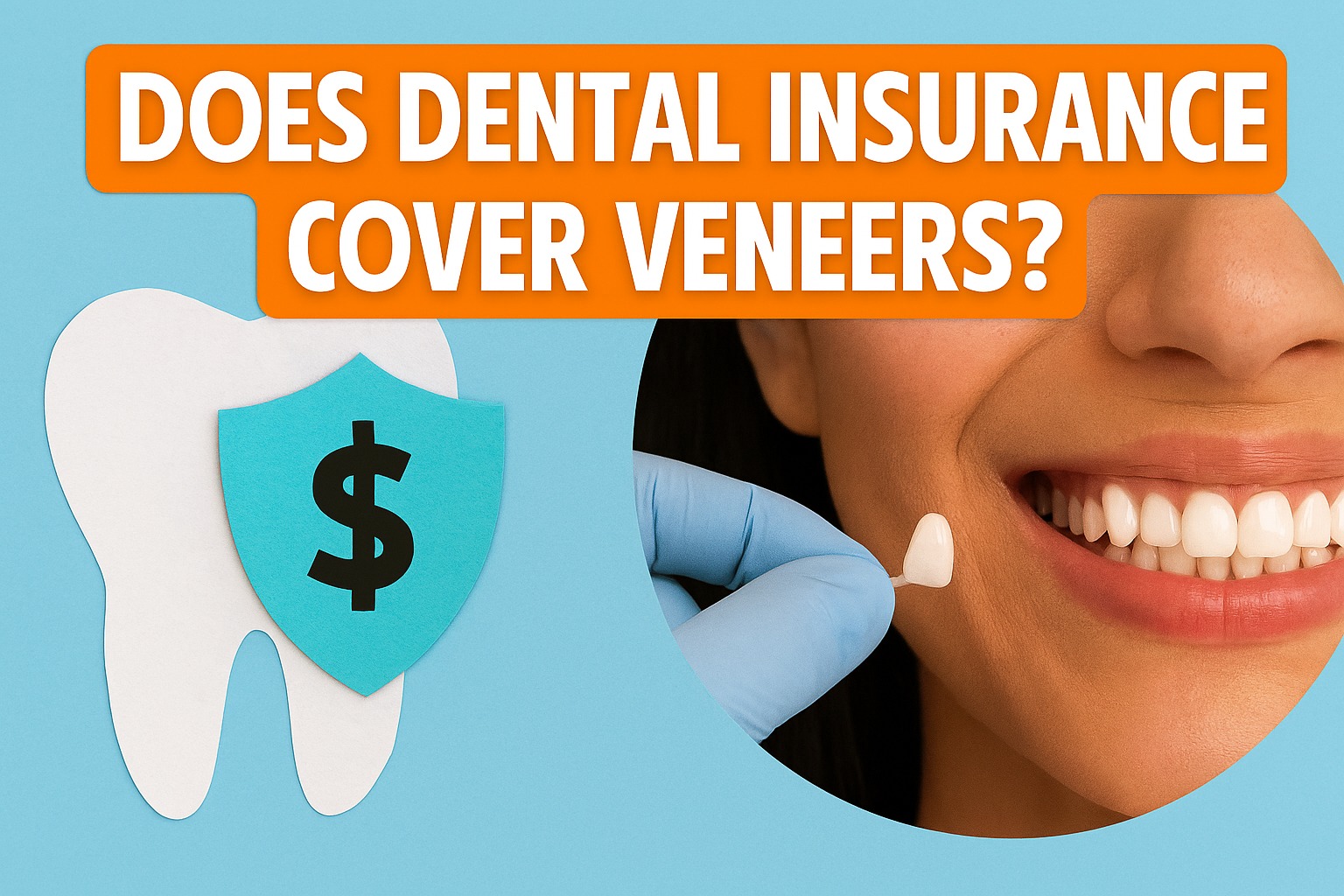Does Dental Insurance Cover Veneers? Complete 2025 Coverage Guide

Does Dental Insurance Cover Veneers? Complete 2025 Coverage Guide
Does dental insurance cover veneers? This question is one of the most common among patients planning cosmetic dental treatments. While most insurance plans exclude veneers as cosmetic, there are exceptions for medically necessary cases. This guide explores when insurance covers veneers, available alternatives, and smart financial options to make your smile transformation affordable.
This guide breaks down everything you need to know about veneer coverage, costs, and practical solutions to achieve your dream smile without financial stress.
What Are Dental Veneers and Why They Matter
Dental veneers are thin, custom-crafted shells bonded to your teeth's front surface to dramatically enhance your smile. Made from porcelain or composite resin, these restorations address multiple aesthetic concerns in one treatment.
They effectively correct discolored teeth resistant to whitening, worn enamel, chipped or cracked teeth, misaligned teeth, irregular shapes, and gaps between teeth. Porcelain options last 10-15 years with proper maintenance, while composite versions typically last 5-7 years.
The procedure requires minimal tooth preparation, making it less invasive than crowns while delivering transformative results. Most patients need 6-8 veneers on upper front teeth for a complete smile makeover.
Understanding Insurance Coverage for Cosmetic Dentistry
Why Most Dental Insurance Plans Don’t Cover Veneers
Insurance companies categorize veneers as cosmetic procedures, which means they enhance appearance rather than treat disease or restore function. This classification automatically excludes them from standard benefits, similar to teeth whitening or aesthetic bonding.
The distinction between cosmetic and restorative care determines coverage. Procedures addressing health problems, decay, or functional issues receive coverage, while aesthetic improvements typically don't.
When Does Dental Insurance Cover Veneers?
Does dental insurance cover veneers in any situation? Yes, when medical necessity can be demonstrated. Coverage may apply for teeth damaged in accidents or injuries, severe tooth decay requiring extensive restoration, congenital defects affecting tooth development, or medication-induced discoloration impacting psychological health.
Securing coverage requires comprehensive documentation from your dentist including clinical photographs, X-rays, detailed treatment plans, and medical justification showing functional impairment. Even with approval, expect only partial coverage, typically 50% or less, subject to annual maximum limits.
Veneer Costs When Dental Insurance Doesn’t Cover Them
Investment Breakdown by Material Type
Understanding pricing helps you plan effectively. Porcelain veneers range from $925 to $2,500 per tooth, offering superior durability, stain resistance, and natural aesthetics that closely mimic real enamel.
Composite resin options cost $250 to $1,500 per tooth. Though less expensive and completable in one visit, they're less durable and more prone to staining than porcelain alternatives.
A complete eight-tooth transformation costs $7,400 to $20,000 for porcelain or $2,000 to $12,000 for composite materials. These represent national averages; your actual investment varies based on location and provider expertise.
Price Influencing Factors
Geographic location significantly impacts costs. Metropolitan areas like New York or Los Angeles charge substantially more than smaller cities or rural regions.
Dentist expertise matters considerably. Board-certified cosmetic specialists with extensive training command premium rates, but their experience often justifies the investment through superior outcomes.
Treatment scope affects pricing but may unlock volume discounts. Many practitioners offer reduced per-tooth rates for multiple veneers in one treatment plan.
Material quality and laboratory fees also influence final costs. Premium dental laboratories using advanced techniques increase expenses but typically deliver superior craftsmanship and longevity.
Major Insurance Providers and Veneer Policies
Coverage Reality Check
Delta Dental, Cigna, Aetna, and MetLife explicitly exclude cosmetic procedures from standard coverage. Their policies categorize most veneer applications as aesthetic treatments ineligible for benefits.
However, these providers may consider coverage when dentists demonstrate medical necessity through proper documentation. Some premium plans offer limited cosmetic benefits as add-ons, though these come with higher premiums and may still exclude veneers specifically.
Annual Maximums and Coverage Percentages
Most dental plans cap annual benefits at $1,000 to $2,000. This represents the total amount paid for all procedures in one calendar year, regardless of actual costs.
Coverage typically follows this structure: preventive care at 100%, basic procedures at 70-80%, and major procedures at 50%. Medically necessary veneers would likely fall into the major category at 50% coverage.
Additionally, plans impose 6-12 month waiting periods for major procedures before coverage begins. You cannot enroll and immediately receive benefits for veneer treatment.
Alternatives When Dental Insurance Doesn’t Cover Veneers

How Discount Plans Work Differently
Dental discount plans provide excellent alternatives for cosmetic procedures. These membership programs offer immediate access to discounted rates at participating dentists with no waiting periods, annual maximums, or claims processing.
Members pay $100 to $200 annually for individuals or $150 to $350 for families. In return, they receive 20-60% discounts on most procedures, including cosmetic treatments like veneers.
For example, a $1,500-per-tooth procedure with 30% discount drops to $1,050 per tooth. For eight veneers, that's $3,600 in savings, far exceeding the annual membership fee.
Popular options include 1Dental, DentalPlans.com, Careington, and Aetna Dental Access. These networks span the country, making it easy to find quality participating providers.
Comparing Discount Plans to Traditional Insurance
Traditional insurance requires monthly premiums, imposes annual benefit caps, enforces waiting periods for major work, involves deductibles and copays, requires claims processing, and typically excludes cosmetic procedures.
Discount plans charge membership fees, have no benefit maximums, provide immediate access, require no paperwork, offer instant savings at service time, and include cosmetic procedures in the discount structure.
For cosmetic dentistry, discount plans often provide superior value since traditional insurance rarely covers these treatments anyway.
Flexible Financing Options for Veneers Without Dental Insurance
In-House Payment Plans
Many dental practices offer internal financing allowing you to spread costs over 6-24 months, often with little or no interest during promotional periods. This makes treatment accessible without requiring full upfront payment.
Healthcare Credit Cards
CareCredit and LendingClub Patient Solutions specialize in medical and dental financing. They offer promotional 0% interest periods for 6, 12, 18, or 24 months depending on treatment cost. Paying off the balance during the promotional period eliminates interest charges entirely.
Personal Loans and Third-Party Financing
Personal loans from banks or credit unions provide another avenue, especially with good credit. These offer fixed monthly payments and clear payoff timelines.
Some practices partner with healthcare lending specialists offering flexible terms tailored specifically to dental procedures.
Insurance-Covered Alternatives Worth Considering
Dental Bonding as a Budget Option
Dental bonding uses tooth-colored composite resin to repair chips, close gaps, or improve tooth color. Costing $100 to $400 per tooth, insurance may cover it when there's structural damage rather than purely aesthetic concerns.
Crowns for Structural Issues
Dental crowns cover entire teeth and receive insurance coverage when medically necessary for structural support after root canals, large cavities, or significant damage. Crowns cost $800 to $3,000 per tooth, with insurance often covering 50% after your deductible.
Orthodontic Treatment Options
Traditional braces or Invisalign address alignment issues, gaps, and crowding. Many plans provide orthodontic coverage, typically $1,000 to $2,000 lifetime maximum for adults, though this varies by policy.
Maximizing Your Benefits: Strategic Approaches

Securing Pre-Authorization
Before proceeding, request pre-authorization from your insurance company. Your dentist submits a detailed treatment plan including procedure codes, clinical justification with documentation, estimated costs, and sometimes photographs or X-rays.
The insurer reviews this information and provides written response indicating coverage status, percentage, and payment amount. This eliminates surprises and enables financial planning.
Initial denials don't mean the end. Many patients successfully appeal by providing additional medical documentation, specialist letters, treatment alternative comparisons, and detailed functional impairment explanations.
Combining Payment Methods Strategically
If insurance provides any coverage, combine it with other payment methods to reduce out-of-pocket expenses.
Use your insurance annual maximum first, then apply Health Savings Account or Flexible Spending Account funds to cover additional costs with pre-tax dollars. Many don't realize HSA and FSA funds can be used for medically necessary cosmetic dental procedures.
Timing procedures across calendar years might access two years of benefits by starting treatment in December and completing in January, effectively doubling your annual maximum.
Essential Questions for Your Insurance Provider
Get clarity before committing to treatment. Ask: Does my plan cover veneers under any circumstances? What documentation demonstrates medical necessity? What is my annual maximum and current usage? What percentage will be covered? Are there applicable waiting periods? Which dentists are in-network? What is the appeals process for denials?
Document all conversations including representative names, dates, and reference numbers. Written confirmation protects you if disputes arise later.
Taking Action: Your Next Steps
Compare All Available Options
Thoroughly review your current dental insurance policy to understand coverage parameters. Contact your provider directly to discuss veneer coverage possibilities and medical necessity requirements.
Research dental discount plans in your area, comparing membership fees, discount percentages, and network dentists. Many websites allow zip code searches to find participating providers nearby.
Calculate potential costs under different scenarios: full out-of-pocket, with dental discount plan, with potential partial insurance coverage, and financing options with estimated monthly payments.
Schedule Professional Consultations
Once you've explored financial options, schedule consultations with cosmetic dentists in your area. Many offer complimentary initial consultations where they'll examine your teeth, discuss goals, explain treatment options, and provide detailed cost estimates.
Bring information about insurance coverage and discount plans you're considering. The dental office can verify benefits, confirm participation in discount programs, and clarify your total investment.
Request before-and-after photos of previous patients, inquire about the dentist's cosmetic dentistry experience and training, discuss material options with pros and cons, and understand the complete treatment timeline.
Common Questions About Veneers and Coverage

Does Medicare or Medicaid pay for veneers?
Medicare excludes most dental care, including veneers. Medicaid coverage varies by state but generally only covers medically necessary procedures, with veneers typically considered cosmetic and excluded.
Can I get coverage if veneers are medically necessary?
Yes, when your dentist documents that veneers restore function, repair accident damage, or address medical conditions affecting oral health, some plans may provide partial coverage. This requires comprehensive documentation and pre-authorization.
How long after enrolling does coverage begin?
Most plans impose 6-12 month waiting periods for major procedures before coverage starts. This prevents enrollment only when expensive treatments are needed. Dental discount plans typically have no waiting periods.
Are veneers tax-deductible expenses?
Medical and dental expenses exceeding 7.5% of adjusted gross income are tax-deductible. If veneers are medically necessary rather than purely cosmetic, they may qualify. Consult a tax professional for situation-specific guidance.
What differentiates insurance from discount plans?
Insurance involves monthly premiums, deductibles, annual maximums, and coverage percentages for approved procedures. Discount plans charge membership fees and provide immediate percentage discounts on all procedures at participating dentists, with no maximums, waiting periods, or claims.
Make Your Dream Smile a Reality
Does dental insurance cover veneers? While traditional coverage remains rare, multiple pathways make this transformative treatment accessible. Whether through dental discount plans, strategic use of insurance benefits for medically necessary cases, or flexible financing options, achieving your ideal smile is more attainable than you might expect.
Take time to research your options thoroughly, consult with experienced cosmetic dentists, and choose the financial approach that best fits your situation and budget. Your perfect smile is an investment in your confidence and quality of life.
Ready to transform your smile? Schedule a consultation with a cosmetic dentist today to discuss your options and create a personalized treatment plan that works for your budget.




